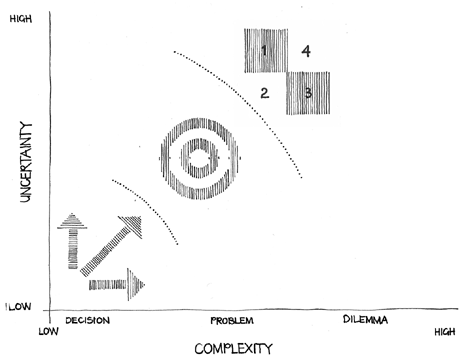by Alex Lowy
Perhaps the single most important lesson in the book, No Problem, is that not all problems are problems. Sounds confusing at first, but stay with me.
Challenging issues differ depending on two factors – complexity and uncertainty. Complexity is about the level of interdependency between forces in a situation. Uncertainty describes the extent to which you can predict influences and outcomes.

Make Decisions
When complexity and uncertainty are relatively low, you have decisions. The essence of making decisions well is being clear about what is being decided, and knowing both the options and the criteria that will be applied.
Think about situations like choosing a restaurant for dinner or a supplier for your business.
Whether the issue is mundane or very important the basic method for making decisions is to list your options and apply your criteria. Your goal is to apply the right (relevant & accurate) information in an organized way, and to prevent irrational factors like fears, assumptions and biases from interfering with the process. The steps are straightforward, but applying them is often tough. And don’t confuse this with simply being “rational”. Decision making often requires checking in with your feelings and your heart to know how you feel about something. The key is doing it within the decision making process, so for example, one of your criteria for picking a supplier could very well be ‘feeling comfortable and trusting” them.
Solve Problems
When complexity and uncertainty are somewhere around middle intensity, you are dealing with a problem. Problems need to be solved. And the great thing about problems is that they can be solved. Problems are situations where there is a discernable gap between what is happening and what is expected or ideal. In problem solving, we find a way to fix that. There are two paths to solving problems, rational and creative. With the former, we work hard to identify root causes and then address them, while in creative efforts, we need to tap our unconscious and associative powers to “invent” a solution. For many problem solving situations, both rational and creative methods are needed, and not surprisingly, the best problem solvers tend to be good at both.
Want an example? You’re in the bottling business and the packaging materials are falling apart enroute to customers. This didn’t used to happen, but now it does. A root cause approach would search for what’s changed that might lead to the problem. And if this didn’t surface anything, a creative approach might look for ways to deliver the product without the need for packaging at all. Creative approaches are often the right way to go when you’ve reached a stuck point, but still believe there is a solution to the problem.
Manage And Exploit Dilemmas
When complexity and uncertainty are high, you are facing a dilemma. Dilemmas are situations where a great deal is at stake and you feel torn between opposing forces. Much as you might wish you could simply choose one or the other direction, with dilemmas it’s just not that simple. Each option has advantages but also consequences which need to be considered. Should I do what my head is telling me to do, or should I follow my heart? Is it better to play it safe in a particular situation or to be risky?
Examples of dilemmas are all around us. When you’re purchasing a new car, do you pick the one you find most exciting or the one that will meet the practical needs of your family? When expanding your business, do you need to borrow money or take on equity partners? With dilemmas, it’s important to address the core tension directly with courage and integrity. It always feels a little scary working with real, important dilemmas, but it is also exciting and it frees up energy. Not surprisingly, the best leaders and critical thinkers do it with courage and grace.
Know Your Approach
So, why do we care about making distinctions between these three levels of challenge? Because for each there is a different approach and attitude that works best, and if you use the wrong one, your chances of success are seriously diminished. In the next post, I’ll get into some of that.

Comments are closed.